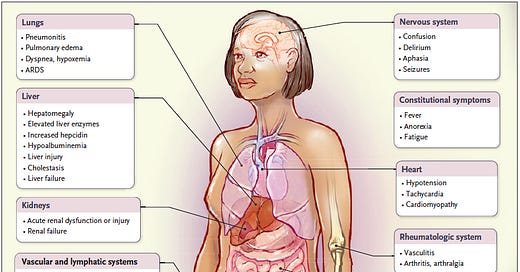Pfizer jabs create the perfect Cytokine Storm
All of the Adverse Events reported after Pfizer jabs can be attributed to Cytokine Storm triggered by Endotoxins known to be in every vial.
All Pfizer Jab Symptoms fit Endotoxin Damage
I have been looking for a suitable illustration of the effects of the Pfizer jabs on the human body and suggested, during a video conference1 with my friends discussing the US Court ordered release of Pfizer trial and post-marketing experience Adverse Events, that someone with the necessary artistic skills could draw a figure and point to all of the sites and organs affected.
Well, I am delighted I found a perfect work of art that does the trick.2
Every Adverse Event in this figure is observed after Pfizer jabbing. Click to enlarge.
What is missing however is consideration of Endotoxin damage to the reproductive system.3
I have written a series of articles with a focus on Endotoxin contained in every vial of Pfizer jabs, and how all of the biochemistry and toxicology fits the pattern.
We do not need to dwell on the complementary toxicity of Spike Protein or Lipid Nanoparticle constituents because Endotoxin is far more toxic at Nanogram or Picogram levels.
Endotoxin is so dangerous, researchers can detect it at Femtogram concentration in body fluids.4
Endotoxin causes all the common symptoms of Pfizer jabs, including Fatigue, Headache, Muscle Pain, Shivering (Chills), decreased Alertness, Energy, Focus, “Pep” and Social Interest5, Nausea, Abdominal Pain, Vomiting and Diarrhea.
Endotoxin is behind the Lethal consequences of Pfizer jabs within a few days to months, such as Anaphylaxis6 and Heart Attack.7
Turbo Cancer is easily explained by Endotoxin.8
How Pfizer Endotoxin causes the Cytokine Storm
As mentioned previously9 Human volunteers injected with E Coli Endotoxin show immediate increase of inflammatory cytokines TNF-α, IL-6, IL-10, and IL-1RA.
The epigenetics behind this increased expression of toxins is well understood, but a vast subject still being investigated in minute detail by thousands of scientists.10
The Eyes are especially sensitive to Endotoxin Cytokine Storm.11
Tumor Necrosis Factor is Lethal in Synergy with Interferon gamma
Experiments in Rodents, which are more resistant to E Coli Endotoxin than Humans, has shown that Lethal Cytokine Storm from Endotoxin involves synergy between Tumor Necrosis Factor Alpha (TNF-α) and Interferon Gamma (IFN-ɣ).12
Older mammals are killed by lower doses of Endotoxin
Despite the wide age range, the majority of people killed by Pfizer (and Moderna) jabs are older, as found in my analysis working with data mining friend Openvaet of VAERS reports.13
A study in Mice found that Aged mice were 16 times more likely to die than younger Mice when injected with E coli Endotoxin, based on dose in milligrams per kilogram.14 Levels of (TNF-a), IL-1a, and IL-6 were monitored after intraperitoneal injection. Gamma interferon (IFN-ɣ) was detectable at 3 h, and sustained high levels were still detected after 12 h in both age groups. The authors suggested that older animals may have been primed and therefore carrying antibodies that increased the severity of the Endotoxin shock.
Conclusion
The evidence is overwhelming that the Endotoxin in mRNA jabs manufactured using E coli is at unacceptable levels. In a future article I will discuss why Pfizer can’t remove the Endotoxin and therefore this approach to making jabs must be banned.
Please consider a paid subscription if you have learned something new today.
Erika Delph. 2023. Minutes of Video Conference 19 February 2023.
Fajgenbaum DC and June CH. 2020. https://www.nejm.org/doi/full/10.1056/NEJMra2026131
Cadaret CN, et al. 2021. Lipopolysaccharide endotoxin injections elevated salivary TNFα and corneal temperatures and induced dynamic changes in circulating leukocytes, inflammatory cytokines, and metabolic indicators in wether lambs. https://academic.oup.com/jas/article/99/6/skab120/6237829
Doherty GM et al. 1992. https://pubmed.ncbi.nlm.nih.gov/1506688/
https://openvaet.org/usa_moderna_pfizer_deaths_by_groups?currentLanguage=en
Tateda K, et al. 1996. https://journals.asm.org/doi/10.1128/iai.64.3.769-774.1996




